Daniel A. Masters's Blog, page 5
June 16, 2025
Fighting on the Bushwhacking Plan: The 134th Ohio at Bermuda Hundred
When theOhio National Guard was federalized in May 1864, it was done with theunderstanding that the men would be utilized as rear area troops, performinggarrison and guard duty and by so doing, freeing up veteran troops who would besent to the front. Little did they know that some of the Guardsmen would go tothe front, too. But that was the case with the 134th Ohio.
Raised from the guard companies of Champaign,Shelby, and Hancock Counties, the 134th Ohio originally was deployedat Cumberland, Maryland guarding the Baltimore & Ohio Railroad. But inearly June, the regiment received orders to move to Washington and from there, sailedto Bermuda Hundred in Virginia. On the night of June 16th, a portionof the regiment was sent to the front as pickets and the following day foundthemselves in a hot fight near Port Walthall.
“During the whole day, we had to fighton the bushwhacking plan,” remembered Private William Mayse of Co. A. “We letthem know we could fire from behind trees as well as they could. We kept themin very close to their breastworks all day. Captain Weaver, while passing downthe line giving orders to his men, was the object of a great many shots fromthe Rebel guns. I don’t see how he possibly escaped. He handled his men wellregardless of the bullets and kept us concealed as much as we could be to saveus from the sharpshooters. He also had the boys save their fire until they hada good sight on a Rebel.”
The following account of the fightingat Bermuda Hundred first saw publication in the July 7, 1864, edition of the UrbanaCitizen & Gazette. William Mayse had previously served as a captain in the 86th Ohio but chose to go into the ranks as a private in the 134th Ohio.
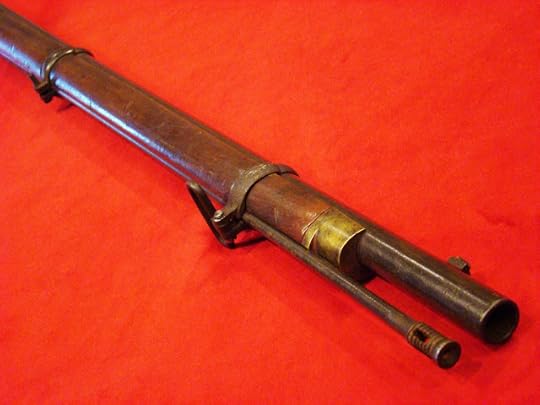 The 134th Ohio was equipped with .577 caliber Enfield rifle muskets shortly after mustering into Federal service in May 1864 but thought they would have little opportunity to burn powder. The fortunes of war proved otherwise and regiment spent more than two months at Bermuda Hundred on both entrenching and picket duty.
The 134th Ohio was equipped with .577 caliber Enfield rifle muskets shortly after mustering into Federal service in May 1864 but thought they would have little opportunity to burn powder. The fortunes of war proved otherwise and regiment spent more than two months at Bermuda Hundred on both entrenching and picket duty. Five milesof Bermuda Hundred, Virginia
June 19,1864
Amidst the haste of camp, the hurriedtramp of soldiers to and fro, and in front of the great army, I shall endeavorto write a few lines. Although we are part of the grand army that is makingnews for the day and history for the future, we at present known but little ofwhat is going on. But we do know that we are encamped on a piece of table land,the soil of which is very sandy and light, and which the sun shines down uponwith full power. When the wind blows or trains pass us, we become engulfed in suffocatingdust. This country abounds with dust and flies.
We are as near to the front as we canbe to be encamped. Nothing but a breastwork and pickets are between us and theenemy. During the last five days, we have all had hard work. The field officersgo with their men and share the same privations. So we can’t say they have putus on duty so they may have an easy time. The whole army has to rise at 3:30a.m., a little earlier than we like. It has been our lot for several days pastto do duty every day and night. The losing of sleep is the hardest part.
Last night, 225 men were detailed to dig trenches and thebalance remained behind the breastworks to be ready to repel any attack thatmight be made. We don’t mind this, for it is guarding the State of Ohio and theboys say that is what the National Guards are for. Lieutenant General U.S.Grant accompanied by Major General Benjamin Butler and staff rode to the fronta few days ago. The passed by our camp and rode alongside the breastworks toexamine them.
Last Thursday evening [June 16], Co. A(Captain Weaver) with two men from each of the other companies were detailed aspicket guard. We were taken out and posted on the line that the enemy occupiedthe previous morning. The night passed off and at early morn as seemed well. Alittle after sunrise, the enemy appeared in our front and began to fire at us.Unfortunately for us, they have a trench but a short distance in front of uswhich they occupied. They being in strong force in their ditches, they had theadvantage of us but we kept them from advancing for some time. We being soexposed to their sharpshooters, we thought it best to tail back a shortdistance in the woods under shelter. While going back, the Rebels thought we werefinally giving away and came out boldly and attempted to follow us. But we soonturned and drove them back to their trenches and remained in their front andunder fire from morning until 7:30 p.m.
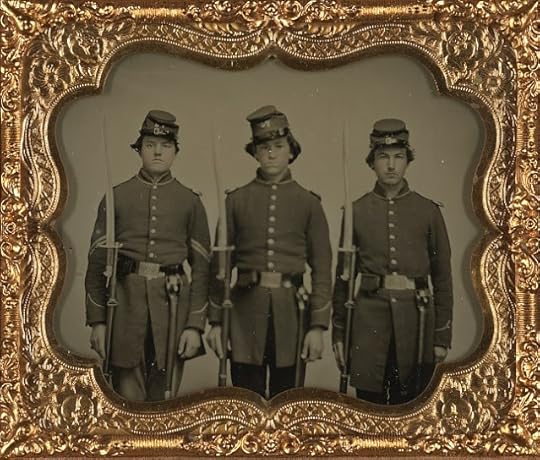 Unidentified Federals equipped with Enfields and sword bayonets.
Unidentified Federals equipped with Enfields and sword bayonets. During the whole day, we had to fighton the bushwhacking plan. We let them know we could fire from behind trees aswell as they could. We kept them in very close to their breastworks all day.Captain Mat Weaver, while passing down the line giving orders to his men, was theobject of a great many shots from the Rebel guns. I don’t see how he possiblyescaped. He handled his men well regardless of the bullets and kept usconcealed as much as we could be to save us from the sharpshooters. He also hadthe boys save their fire until they had a good sight on a Rebel. LieutenantLemen was also assisting in the front with us. We gave the Rebels some of ourbest shots. All the men did very well and deserve credit.
Being in the front with the boys, I know all about theskirmish. But with sorrow and regret, I will have to relate to you ourcasualties. Elias J. Busser of Co. A was shot in the head and soon died. He wascarried from the field to a house nearby where he was put in an ambulance andconveyed to the general hospital. Every care was bestowed by his brother andothers of his company to relieve his suffering. He received the fatal shotabout 10 a.m. and died about 3 p.m. His brother [Young Busser], with all the assistance hewished, had him taken to Bermuda Hundred to be embalmed and today he was senthome by express. What sacrifices our country is demanding. Mr. Busser’s familyhave our deepest sympathies. Let it be recorded that Elias died fighting forall that the American loyal people hold dear: their country.
Archibald T. Buckles of Co. A received a flesh wound in theright leg above the knee. Archy takes it with a good deal of humor and willsoon be ready for the Rebs again. Reuben Alden of Co. C was mortally wounded,shot in the abdomen. He has been sent to Fortress Monroe [where he died June 24, 1864]. John A. Hunt of Co. Hwas shot in the hand. Absalom Poland of Co. B was shot in the leg below theknee. [Both Hunt and Poland survived their wounds.]
 General Benjamin Butler's headquarters camp at Bermuda Hundred
General Benjamin Butler's headquarters camp at Bermuda HundredNow we are willing to obey all orders and never wish toflinch from duty, but if going to the front and fighting the enemy the same asthe old veterans do is garrison duty as we were told would be our work, thenlet no more promises be made. We came here perfectly willing to build andoccupy fortifications. All seemed to be pleased. But when we were brigaded withveterans and sent out to drive back the enemy the same as veterans would, wethink is more than most the men expected. We are not well drilled, have neverbeen under fire, hardly used to camp life, and other good reasons could beoffered.
Now bear in mind I have just written the feelings of most ofthe 100 days’ men. Of course, many of us have seen enough service to do allthat is required of soldiers. But none of us will do an act that would make anyin Ohio blush. We will obey all orders as we have heretofore promptly done. Ifit be our lot to repel Rebels, to go to the field and fight, we will do so anddo the best we can.
For the last five days we have heard the incessant roar ofcannonading and musketry. The very air has been darkened with battle smoke anddust. Most of this cannonading is at Petersburg. I understand that GeneralGrant has that place under his control now. There is a constant roaring day andnight. These old veterans say there is as much difference between General Grantand General Grant as there is between a snail and a bird. General Grant israpidly moving all the time, taking some advantageous position by making aflank movement.
Our boys were made glad today as our chaplain returnedbringing considerable mail and telling about home. That is the only mail wehave received since we have been here. In fact, we have received no mail sincewe left Cumberland, Maryland. Other regiments receive their mail. I supposeours will be on in a few days as there is a regular mail line now established.We have a few men sick. Some are at Cumberland, Washington, and FortressMonroe. As they were not seriously sick when I last heard I will not mentiontheir names.
Source:
Letter fromPrivate William Mayse, Co. A, 134th Ohio Infantry, Urbana Citizen& Gazette (Ohio), July 7, 1864, pg. 3
June 14, 2025
With the Wagons at the Battle of Atlanta
It was noon on July 22, 1864. Quartermaster Sergeant Charles Wiles of the 78th Ohio was well behind the lines with the divisional wagon train, or so he thought.
"
At noon while our teams were corralled in the rear of our brigade, we were somewhat surprised at the appearance of a battery taking position on a hill just above us and the forming of a line of battle by a detachment of the 16th Corps," Wiles observed. "The sight was really beautiful, but foreboding of a fight, the character and approach of which we as yet knew nothing about. We were at once on the alert with everything in the wagons awaiting orders from our brigade quartermaster to move out. Five minutes had scarcely elapsed when we were ordered to move; the whips cracked sharply over the mule’s backs and we were moving hastily to the rear (if any there was) while the above mentioned battery started throwing its deadly missiles among the ranks of the advancing Rebels."Sergeant Wiles’ account of the epicBattle of Atlanta first saw publication in the August 11, 1864, edition of the ZanesvilleDaily Courier.
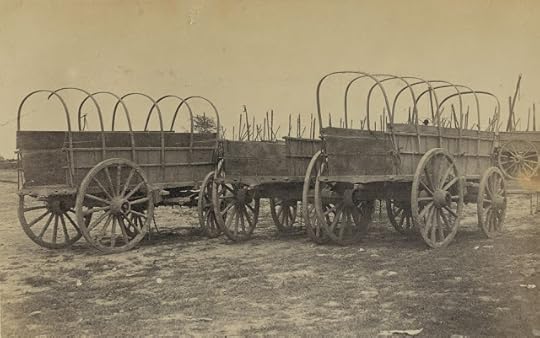 Sherman's army depended first and foremost upon the railroads to maintain its logistical underpinnings, but the hard and heavy work of getting those supplies to the troops in the field fell upon sturdy army supply wagons such as the ones pictured above. Often pulled by six mule teams, supply trains usually did not function well under fire as the mules would quickly become panicked by the noise and confusion of battle. A mule stampede could be deadly to both man and beast.
Sherman's army depended first and foremost upon the railroads to maintain its logistical underpinnings, but the hard and heavy work of getting those supplies to the troops in the field fell upon sturdy army supply wagons such as the ones pictured above. Often pulled by six mule teams, supply trains usually did not function well under fire as the mules would quickly become panicked by the noise and confusion of battle. A mule stampede could be deadly to both man and beast. Camp nearAtlanta, Georgia
July 29,1864
Dearbrother,
Your letter mailed the 16thI received several days since together with one mailed the 13thcontaining stamps, combs, and good news generally. The combs, each of which Itried immediately upon opening the letter, give entire satisfaction. Bothletters I assure you would have been answered ere this had we not been on themove constantly ever since their receipt. Today we (I refer to our train) are encampedupon a hill by the side of a beautiful creek while the 78th Ohio ison the battle line monetarily expecting an attack from the Johnnies.
The past 10 days have been days ofremarkable as well as sad events. Many an undaunted Rebel is today non est,being summarily discharged by Yankee bullets and many, very many more, are incapacitatedby wounds from ever bearing arms again against their country and their own bestinterests, while a comparatively large number are our prisoners, being taken inas the boys familiarly term it. Would to God that they were all taken in orforced to surrender and forced to sue for peace; this is my prayer.
I will give you an outline of ourhistory during the past two weeks. Leaving our position on the right themorning of July 16, we arrived at Marietta the evening of the same day. Theplace presents a gloomy aspect though once perhaps the seat of wealth and prosperityas well as Southern chivalry and refinement. Leaving Marietta the morning ofthe 17th, we passed through Roswell, the seat of the RoswellFactory, rather extensively engaged in the manufacture of clothing for theRebel government, but now almost totally destroyed, having been burned by the16th Army Corps which passed the that place on the 29th.
Crossing the far-famed ChattahoocheeRiver at this place and marching some 3 miles distant, we encamped for thenight. The three days following were consumed with reaching Decatur, being onthe railroad running to Charleston, South Carolina, which road was at oncedestroyed for some distance. Decatur, like all Southern towns through which thearmy passes, is dilapidated and almost wholly deserted by the inhabitants. Ourcorps, the 17th, moved up and took position on the left during theafternoon of the 20th.
On the 21st, heavyskirmishing was kept up during the entire day while the Rebels occupied thenight massing their forces on our flank and the left center, held by Logan’s 15thCorps which expected movement of the Johnnies, was not discovered until themorning of the 22nd by our officers when considerable exertion wasmade to meet it. Nevertheless, this day was destined to be the scene of adreadful battle. At noon while our teams were corralled in the rear of ourbrigade, we were somewhat surprised at the appearance of a battery takingposition on a hill just above us and the forming of a line of battle by adetachment of the 16th Corps. The sight was really beautiful, butforeboding of a fight, the character and approach of which we as yet knewnothing about.
We were at once on the alert witheverything in the wagons awaiting orders from our brigade quartermaster to moveout. Five minutes had scarcely elapsed when we were ordered to move; the whipscracked sharply over the mule’s backs and we were moving hastily to the rear(if any there was) while the above mentioned battery started throwing itsdeadly missiles among the ranks of the advancing Rebels. At this moment, Isnatched from a wagoner our old split-bottomed chair which I stood upon andwatched the fiend-like Rebels as they filed through an embrasure in the woodssome 300 yards distant. Soon they came to a front then a charge ensued; suchmusketry and artillery firing! The bullets flew as thick as hail and the shellsburst in every direction. Health and self-preservation prompted me to find amore secure position as I was totally unarmed and had no business anywhereexcept with our teams.
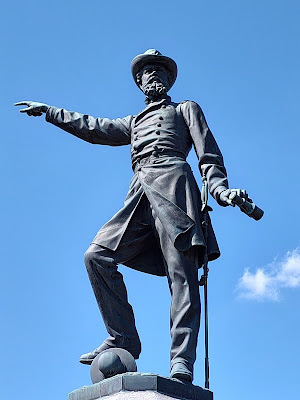 General James B. McPherson commanding the Army of the Tennessee was killed in one of the opening moves of the Battle of Atlanta.
General James B. McPherson commanding the Army of the Tennessee was killed in one of the opening moves of the Battle of Atlanta. At this junction, the Rebels advancedupon our brigade in front and almost simultaneously upon their rear, compellingthe boys to climb from one side of their earthworks to the other, at the sametime discharging their pieces and clubbing the Rebs from the works with thepieces reversed. Terrible was the conflict but like devils, our boys repulsedevery onset until the Rebs lay in piles right in their own ditches, stillholding their position. The color guards of the 78th Ohio were allshot down and one of the Rebs in the very act of seizing the colors was senthowling back by a blow from Captain Orr’s saber; the beautiful colors still waveddefiantly not destined to be polluted by Rebel hands. Thus, the battle rageduntil late in the afternoon when comparative quiet was restored.
Now could be heard the moaning of thewounded, heart-rending in the extreme. The living looked around them in searchof their missing comrades, finding some while the fate of others remained unknown.After a night of anxious solicitude, the morning of the 23rd dawnedand the boys resumed the search among the dead and wounded for their missing comradesfinding one dead here, another wounded there, and so on. Suffice it to say thatthe loss in our regiment in killed, wounded, and missing was 111 men.
Such a battle the veterans of the 78thOhio say they never participated in or ever wish repeated. For my part, I wouldfeel contented should I never again be compelled to witness such a terriblebattle. The general health of the regiment is not so good as might be expected.Diarrhea and flux prevail to some extent. My health continues good notwithstandingthe oppressively hot weather we are experiencing. The colonel is now in commandof the brigade, its former commander having been captured during the battle ofthe 22nd. J.P. Springer and son are both well although they areconstantly on the go transferring sick and wounded from the field to thehospitals.
The fate of Atlanta is sealed, it being only a question oftime with General Sherman as to when it shall be taken.
Source:
Letter fromQuartermaster Sergeant Charles C. Wiles, 78th Ohio VolunteerInfantry, Zanesville Daily Courier (Ohio), August 11, 1864, pg. 2
June 13, 2025
I Recognized Him as John Wilkes Booth: An Actor Recalls the Lincoln Assassination
It is rarething that an actor becomes a witness to an event that changed the course of anation’s life, but on the evening of April 14, 1865, Philadelphia-born actorHarry Hawk had the stage to himself at Ford’s Theater, until President Lincoln’sassassin fell upon the stage and brandished a knife.
"I was playing Asa Trenchard in Our American Cousin;the “old lady” of the theater had just gone off the stage and I was answeringher exit speech when I heard the fatal shot fired,” Hawk wrote to his fathershortly afterwards. “I turned, looked up to the President’s box, and heard aman exclaim, “Sic semper tyrannis!” I saw him jump from the box, seize the flagon the staff and drop to the stage. He slipped when he gained the stage but gotupon his feet in a moment and brandished a large knife saying, “The South shallbe free!” He turned his face in the direction I stood and I recognized him asJohn Wilkes Booth. He ran towards me and I, seeing the knife, thought I was theone he was after so I ran off the stage up a flight of stairs. He made hisescape out of the door in the rear of the theater, mounted a horse, and rodeoff.”
Hawk, who had seen Booth earlier in the day on the steps ofFord’s Theater, gave his testimony to the police but within a few days was onthe road again with Laura Keene’s theater company, next stop Cincinnati, Ohio.His letter, sent to his father William J. Hawk in Chicago, first ran in the ChicagoJournal but was picked up and reprinted in numerous newspapers.
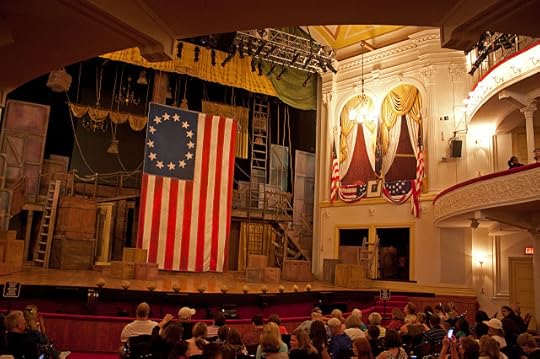 Harry Hawk was standing upon this stage addressing the audience when he heard the shot from Booth's Derringer pistol and saw Booth land upon the stage brandishing a dagger. "He turned his face in the direction I stood and I recognized him as John Wilkes Booth," Hawk said.
Harry Hawk was standing upon this stage addressing the audience when he heard the shot from Booth's Derringer pistol and saw Booth land upon the stage brandishing a dagger. "He turned his face in the direction I stood and I recognized him as John Wilkes Booth," Hawk said. Washington,D.C.
April 16,1865
Dear father,
This is the first opportunity I havehad to write you since the assassination of our dear President on Friday nightas I have been in custody nearly ever since.
I was one of the principal witnesses of that sad affair, beingthe only one on stage at the time of the fatal shot. On that night, the playwas going off so well. In fact, it was one laugh from the time the curtain wentup until it fell, and to think of the sorrowful ending. Mr. and Mrs. Lincolnenjoyed it so much. She was laughing at my speech when the fatal shot wasfired. I was playing Asa Trenchard in Our American Cousin; the “old lady”of the theater had just gone off the stage and I was answering her exit speechwhen I heard the fatal shot fired.
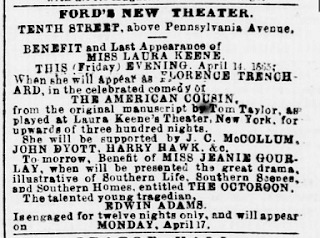
I turned, looked up to the President’s box, and heard a manexclaim, “Sic semper tyrannis!” I saw him jump from the box, seize the flag onthe staff and drop to the stage. He slipped when he gained the stage but gotupon his feet in a moment and brandished a large knife saying, “The South shallbe free!” He turned his face in the direction I stood and I recognized him asJohn Wilkes Booth. He ran towards me and I, seeing the knife, thought I was theone he was after so I ran off the stage up a flight of stairs. He made hisescape out of the door in the rear of the theater, mounted a horse, and rodeoff.
“Whenthe pistol shot was heard in the second box on the right-hand stage of Ford’sTheater, persons in the theater imagined that it was part of the play, hencethe confusion of the audience. Meantime, the assassin appeared on the edge ofbox crying “Sic semper tyrannis” and flourishing a dagger, leaped to the stage.He crossed the stage rapidly exclaiming “revenge” and “I have done it!” Allstarted to their feet and there being cries that the President was shot, thefirst intimation of danger was a call for a surgeon.” ~Daily NationalIntelligencer and Washington Express, April 15, 1865
The above all occurred in the space of a quarter of a minuteand at the time I did not know that the President was shot, although if I hadtried to stop Booth he would have stabbed me. I am now under $1,000 bail toappear as a witness when Booth is tried if caught. You may imagine theexcitement in the theater (which was crowded) with cries of “hang him!” and “whowas he?” from everyone present.
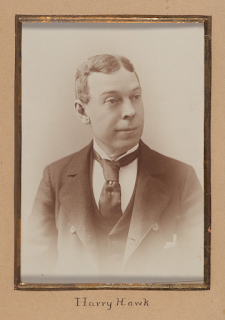 William Henry "Harry" Hawk
William Henry "Harry" HawkAbout 15 minutes after the occurrence, the President wascarried out across the street. I was requested to walk down to the police headquartersand give my evidence. They then put me under $1,000 bond to appear at 10 o’clockthe next morning. I then walked about for some time as the city was wild withexcitement and then I went to bed. At 3:30 a.m., I was called upon by an aideof the President and asked to go the home where he was lying to give anotherstatement to Judge Carter, Secretary [of War] Stanton, and other high officialsassembled there. I did so and went to bed again.
It was the saddest thing I ever knew. The city only the nightbefore was illuminated and everybody was so happy. Now it is all sadness;everybody looks gloomy and sad. It is an episode in my life that I shall neverforget. Enclosed is a piece of fringe of the flag the President was holdingwhen he was shot.
Sources:
Letter from WilliamHenry “Harry” Hawk, Waukegan Weekly Gazette (Illinois), April 29, 1865,pg. 2
“Thepresident was received with great furor,” Daily National Intelligencer andWashington Express (District of Columbia), April 15, 1865, pg. 2
June 12, 2025
Cursing Banks and Franklin: With the 77th Illinois at Sabine Crossroads
CorporalSamuel Van Horne of the 77th Illinois spoke the sentiments of manyof his comrades in the ranks when he found the generalship of GeneralsNathaniel Banks and William B. Franklin lacking in the spring of 1864.
Thinking specifically of the Battle of Sabine Crossroads, Van Horne opined “I don’t suppose you will ever get a true accountof the affair as it was so miserably managed all through. Generals Banks andFranklin will never have it published. It seems to me that any private in theranks would have done better. I tell you it was poorly managed and there is nota soldier in this department but will (or do rather) curse Generals Banks andFranklin.”
Such sentiments are understandable when Van Horne shares thatof the 460 men of his regiment who went into action at Sabine Crossroads, only 160 came out andmany of them (himself included) were wounded. His account of the battle firstsaw publication in the May 16, 1864, edition of the Zanesville Daily Courier.
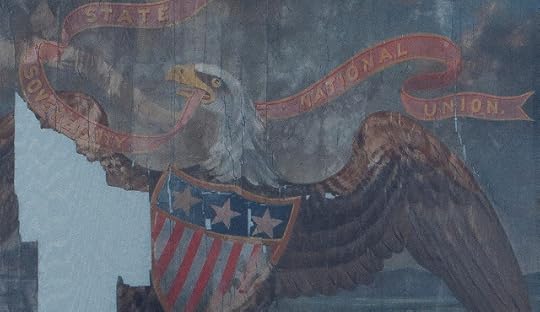 This detailed view of the regimental colors of the 77th Illinois shows a bald eagle and shield with a ribbon calling our state sovereignty and national union. The colors were presented to the regiment by the Misses' Aid Society of Peoria, Illinois.
This detailed view of the regimental colors of the 77th Illinois shows a bald eagle and shield with a ribbon calling our state sovereignty and national union. The colors were presented to the regiment by the Misses' Aid Society of Peoria, Illinois. U.S. GeneralHospital, New Orleans, Louisiana
May 1, 1864
I once more have the opportunity of penningyou a few lines. You see by the heading that I am in the hospital but, thankfortune, not on account of bad health. I suppose ere this you have heard allthe particulars of the battles of Mansfield and Pleasant Hill fought on the 8thand 9th of April. The 77th Illinois with several otherregiments were pretty badly cut up. Our regiment went in with about 460 men andcame out with about 160. Co. B, of course, lost its share in killed andprisoners.
Our brigade was in front and wasdriven back some three or four miles before the enemy could be checked so thatnearly all of our wounded and a great many who were not fell into the enemy’shands. Our company numbered 28 and about 12 came off the field, 5 of themwounded. I received two slight wounds early in the engagement; a Minie ballpassed through my hip just below the joint and not deep enough to strike thebone so it is a slight wound. Another small ball went through my right legbelow the knee, passing through the thickest part of the calf. I think it toois merely a flesh wound and both are doing well. Quite a number with whom youare acquainted are wounded and with me here. George Chambers received a fatalwound and died here in the hospital a few days ago. We know of 7 or 8 who weretaken and I hope without wounds. Four or five of our company came out without ascratch; there are only 8 men left in Co. B commanded by the orderly.
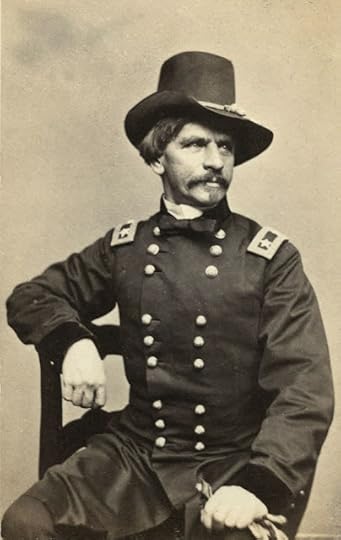 General Nathaniel Prentiss Banks
General Nathaniel Prentiss Banks
I don’t suppose you will ever get atrue account of the affair as it was so miserably managed all through. GeneralsBanks and Franklin will never have it published. It seems to me that anyprivate in the ranks would have done better. Our brigade skirmished from 7 a.m.to 4 p.m. when we met the main enemy 25,000 strong and our brigade onlynumbered 5,000. The Second Brigade came up and was ordered to our right whichgave us no support at all. The Third Division of the 13th Corps wassome 3 or 4 miles in the rear when we first made the attack. They were broughtup on the double quick but were too late to give us any assistance. The enemywas flanking us on both right and left, forcing us to fall back. Still theycame in solid column outnumbering us and driving the Third Division inconfusion.
About the time the fight commenced,the 19th Corps was ordered into camp 6 or 7 miles back. When we weredriven back, the 19th Corps was ordered up while the Third and FourDivisions were still falling back with the Rebels following close behind insolid mass, both flanks moving up with the center. The 19th Corpsheld the enemy in check until dark when the firing ceased. The whole army fellback that night, the 13th Corps as far as Pleasant Hill where wecamped the night before and where General A.J. Smith with the 16thCorps was preparing to meet the enemy. The Rebels followed close up,skirmishing with the 19th Corps until they reached Pleasant Hillwhere General Smith held them until the night of the 9th. Smith wasthen ordered to fall back that night.
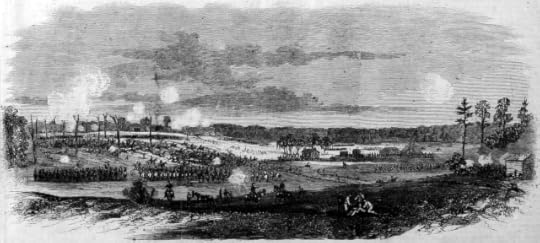 Battle of Sabine Crossroads
Battle of Sabine CrossroadsIt was afterwards found out that theRebs retreated at about the same time Smith did. Smith held his men in a horseshoeshape and trapped the Rebs before they were aware of it and opened on them allat once, just more than mowing them down. The Rebs made three desperate chargesbut were forced back with about one half the number they came up with. GeneralSmith wanted to follow them up but Banks ordered him back. Smith told Banks hewas losing a glorious victory but no attention was paid to this and so he was.I and many others know (or think at least) that General Smith could havecaptured all or nearly all that we lost the day before, but no, he must fallback.
One of the worst features of the wholeaffair was having the train right up front. A long ammunition train was notmore than a mile and a half behind the advance and it blockaded the road sothat the artillery could not get back. The Chicago Mercantile Battery lostevery gun, nearly all their horses, and half of their men. I tell you it waspoorly managed and there is not a soldier in this department but will (or dorather) curse Generals Banks and Franklin.
The wounded here are to be sent homein a few days on 60 days furlough. I should like to see you then.
To learn more about Sabine Crossroads, please check out these posts:
Worse Than Madness for Us: The 56th Ohio at Sabine Crossroads
Every Man for His Own Pork and Beans: The 29th Wisconsin at Mansfield
Source:
Letter fromCorporal Samuel Van Horne, Co. B, 77th Illinois Volunteer Infantry, ZanesvilleDaily Courier (Ohio), May 16, 1864, pg. 2
June 11, 2025
Federal Arms of the Brice's Crossroads Campaign of June 1864
On June 1, 1864, General Samuel Sturgis led an expeditiontotaling about 10,000 men in northern Mississippi. His force consisted of twelveinfantry regiments, ten cavalry regiments (or portions of regiments) and six batteries(or sections of batteries). The march lasted ten days before the resultingBattle of Brice’s Crossroads sent Sturgis’s column tumbling back towardsMemphis in defeat.
A frequent question asked by students of the battle centers around the types of arms carried by the boys in Blue during thiscampaign. Early in the war, state governments, scrambling to gather whateverarms they could secure, sent their troops off to war carrying a mixture of domesticsmoothbores, converted rifled muskets, and any European arms that state agentscould procure ahead of their Federal (and Confederate) competitors. By thesummer of 1864, those days were long gone and the Federal ordnance departmenthad made great strides in standardizing small arms for the infantry.
The following list, compiled primarily from the first andsecond quarter ordnance reports held by the National Archives, listsout the small arms, sabers, and artillery pieces carried by the various Federalunits at Brice’s Crossroads. A few broad general statements can be made. Theinfantry regiments primarily carried .58 caliber Model 1861 Springfield riflemuskets; however, a few regiments (113th Illinois, 93rdIndiana, 72nd Ohio, 95th Ohio, and 59th U.S.Colored Troops) carried a mix of Springfields and P53 Enfield rifle muskets. Allof these were considered first class arms by the War Department.
The arms carried by the ten cavalry regiments proved muchmore diverse and interesting. Like the artillery, several of the cavalryregiments were deployed in detachments as opposed to full regiments. Forexample, the 3rd Illinois Cavalry had four of its twelve companiespresent on the expedition (B, F, I, and M), the 9th Illinois Cavalryhad eight of its twelve companies present, while the 7th IllinoisCavalry was present in its entirety. It appears that nearly every type ofcarbine in the Federal catalog was present at the battle, a veritablecornucopia of Sharps, Burnsides, Merrill’s, Cosmopolitans, Gallagher’s, Gibbs, andStarr carbines. As the war progressed, Federal cavalry units increasinglyturned to repeating arms and the 9th Illinois Cavalry carried .54 caliberColts’ revolving rifles, while the 2nd New Jersey Cavalry carried.52 caliber Spencer carbines.
For close range combat, most (but not all) cavalrymen carriedrevolvers and sabers. The legendary .44 caliber Colt Army revolver was the mostcommon at Brice’s Crossroads, but there were also large numbers of .36 caliberBeals’ revolvers, .36 caliber Whitney revolvers, .36 caliber Colt Navies, and .44caliber Remingtons. For truly close-range action, ten members of the 4thIowa Cavalry even carried .54 caliber single-shot Derringers! The 2ndNew Jersey, however, didn’t carry (or report) any revolvers at all. Interestingly,the old Model 1840 dragoon saber, derisively called the “wrist-breaker” due toits unwieldiness, was by far the most common saber carried by Federal cavalrymenat Brice’s Crossroads although several companies carried the handier Model 1860light cavalry saber.
The organization of Federal artillery in this campaign can be abit perplexing. The artillery contingent of Sturgis’s expedition consisted of22 guns, but only Battery B of the 2nd Illinois Light Artillery waspresent at its full strength of four guns. Battery E of the 1stIllinois Light Artillery had four guns of its six guns on the field, amountingto two sections. The remaining batteries only had single sections of two gunseach on the field: 6th Indiana Battery, 14th IndianaBattery, Battery F of the 2nd U.S. Colored Troops Light Artillery,and 7th Wisconsin Battery. This totals 16 guns; however, both the 4thMissouri Cavalry and 10th Missouri Cavalry had artillery pieces, too;the 4th Missouri carrying four mountain howitzers while the 10thMissouri had two pieces of unknown description, but most likely mountainhowitzers, too.
Determining exactly what types of cannons were utilized atBrice’s Crossroads proved challenging; the expedition lost 16 of its 22 gunsand the Q2 reports generally show what was left of the batteries afterthe expedition; reviewing prior reports was helpful in filling in the gaps butknowing which of the guns was lost proved difficult. For Battery F, 2ndU.S., ordnance records were incomplete so it is unknown what type of ordnancethis battery used during the expedition.
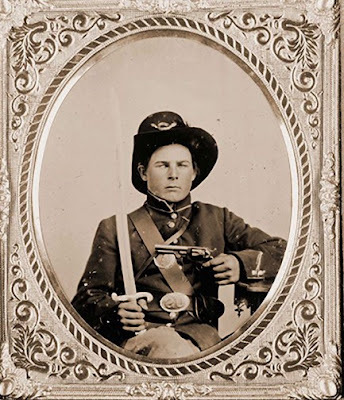 Private George Kimbrue, Co. C, 93rd Indiana Infantry
Private George Kimbrue, Co. C, 93rd Indiana Infantry 81stIllinois Infantry-.58 caliber Model 1861 Springfield rifle muskets
95thIllinois Infantry-.58 caliber Model 1861 Springfield rifle muskets
108thIllinois Infantry-.58 caliber Model 1861 Springfield rifle muskets
113thIllinois Infantry-mixed: 444 .58 caliber Model 1861 Springfield rifle muskets, 133 .577 caliberP53 Enfield rifle muskets
114thIllinois Infantry-.58 caliber Model 1861 Springfield rifle muskets
120thIllinois Infantry-.58 caliber Model 1861 Springfield rifle muskets
BatteryE, 1st Illinois Light Artillery- 6-gun battery (4 guns at battle)
As ofFebruary 9, 1864, five M1857 12-pdr Napoleons, one 3” 6-pdr James rifle
BatteryB, 2nd Illinois Light Artillery- 4-gun battery
As of October29, 1863, four 6-pdr James’ rifles
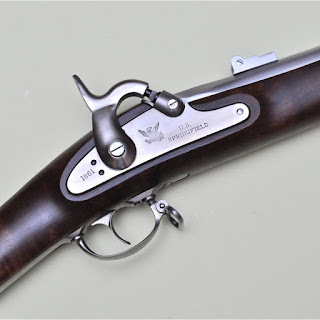 Model 1861 Springfield rifle musket
Model 1861 Springfield rifle musket
3rdIllinois Cavalry- 4 companies at Brice’s Crossroads
*Note: afew companies had a sprinkling of .36 caliber Colt Navy revolvers
Co. B- .54caliber Burnside carbines, .52 caliber Sharps’ carbines, .44 caliber Colt army revolvers,M1860 light cavalry sabers
Co. F- .54caliber Burnside carbines and .52 caliber Sharps’ carbines, .44 caliber Coltarmy revolvers, M1840 dragoon (heavy cavalry) sabers
Co. I- .54caliber Burnside carbines, .44 caliber Colt army revolvers, .36 caliber Beals’revolvers, M1860 light cavalry sabers
Co. M- .52caliber Sharps’ carbines, .44 caliber Colt army revolvers, no sabers listed
7thIllinois Cavalry-.52 caliber Sharps’ carbines, mix of .36 caliber Whitney’s Navy revolvers and.36 caliber Beals’ revolvers, mostly M1840 dragoon (heavy cavalry) sabers with severalcompanies carrying M1860 light cavalry sabers
9thIllinois Cavalry- 8 companies at Brice’s Crossroads
Co. B- .54caliber Colt’s revolving rifles, a few .52 caliber Sharps’ carbines, a few .36caliber Colt Navy revolvers
Co. E- .54caliber Colt’s revolving rifles, a few .36 caliber Colt Navy revolvers
Co. F- .54caliber Colt’s revolving rifles, a few .36 caliber Colt Navy revolvers, a fewM1840 dragoon (heavy cavalry) sabers
Co. H- noreport
Co. I- .54caliber Colt’s revolving rifles, .36 caliber Colt Navy revolvers
Co. K- a few.54 caliber Colt’s revolving rifles, a few .52 Hall’s carbines, .52 caliberSharps’ carbines, .36 caliber Colt Navy revolvers, a few. 36 caliber Beals’revolvers, M1860 light cavalry sabers
Co. L- .54caliber Colt’s revolving rifles, a few .52 caliber Sharps’ carbines, .36caliber Colt Navy revolvers, a few. 36 caliber Beals’ revolvers, M1840 dragoon(heavy cavalry) sabers
Co. M- .54caliber Colt’s revolving rifles, a few .36 caliber Colt Navy revolvers, a few.36 caliber Beals’ revolvers
93rdIndiana Infantry-mixed as follows: 233 .58 caliber Model 1861 Springfield rifle muskets, 118.577 caliber P53 Enfield rifle muskets
7thIndiana Cavalry-.54 caliber Merrill’s carbines, .44 caliber Colt Army revolvers, mostly M1840dragoon (heavy cavalry) sabers with Co. H carrying M1860 light cavalry sabers
6thIndiana Battery-4-gun battery (2 guns at battle)
Per April27, 1864, Two M1841 6-pdr field guns and two 3” 6-pdr James’ rifles
14thIndiana Battery- 4-gun battery (2 guns at battle)
Per May 17, 1864, three M1857 12-pdr Napoleonsand one 3” Ordnance rifle
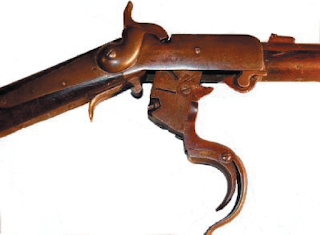 .54 caliber Burnside carbine
.54 caliber Burnside carbine3rdIowa Cavalry- Mixed as follows:
Co. A- .54caliber Burnside carbines, .44 caliber Colt Army revolvers, a few .36 Beals’revolvers, M1840 dragoon (heavy cavalry) sabers
Co. D- .54caliber Burnside carbines, .36 caliber Colt Navy revolvers, M1840 dragoon(heavy cavalry) sabers
Co. E- .54caliber Burnside carbines, .36 caliber Colt Navy revolvers, M1840 dragoon(heavy cavalry) sabers
Co. G- .54caliber Burnside carbines, .36 caliber Colt Navy revolvers, M1840 dragoon(heavy cavalry) sabers
Co. H- .54caliber Burnside carbines, .36 caliber Colt Navy revolvers, a few .36 caliberRemington revolvers, M1860 light cavalry sabers
Co. I- .54caliber Burnside carbines, .36 caliber Beals’ revolvers, M1840 dragoon (heavycavalry) sabers
Co. K- .54caliber Burnside carbines, .36 caliber Beals’ revolvers, M1860 light cavalrysabers
Co. L- .54caliber Burnside carbines, .36 caliber Colt Navy revolvers, a few .36 caliberRemington revolvers, M1860 light cavalry sabers
Co. M- .54caliber Burnside carbines, .36 caliber Colt Navy revolvers, M1860 light cavalrysabers
4thIowa Cavalry:mixed including .52 caliber Spencer carbines (all listed as in storage), .52caliber Cosmopolitan carbines, a few .51 caliber Gallagher carbines (Co. Honly), a few .52 caliber Gibbs’ carbines (Co. M only), 339 .44 caliber ColtArmy revolvers, 166 .44 caliber Remington revolvers, a few .45 caliber Starrrevolvers, 10 .54 caliber Derringer pistols, a few heavy and light cavalry sabers
9thMinnesota Infantry- .58 caliber M1861 Springfield rifle muskets
4thMissouri Cavalry- Mixed as follows:
Co. B- .52caliber Sharps’ carbines, .44 caliber Colt Army revolvers, a few .44 caliberRemington revolvers, a few .36 caliber Remington revolvers, a few .36 caliberBeals’ revolvers, M1840 dragoon (heavy cavalry) sabers, four Mountain Howitzers
Co. D- .51caliber Gallagher’s carbines, .52 caliber Sharps’ carbines, .44 caliber ColtArmy revolvers, .44 caliber Remington revolvers, a few .36 caliber Beals’revolvers, M1840 dragoon (heavy cavalry) sabers
Co. F- .51caliber Gallagher’s carbines, .36 caliber Colt Navy revolvers, M1840 dragoon(heavy cavalry) sabers
Co. G- .51caliber Gallagher’s carbines, .52 caliber Sharps’ carbines, .44 caliber ColtArmy revolvers, .36 caliber Remington revolvers, a few .36 caliber Beals’revolvers, M1840 dragoon (heavy cavalry) sabers
Co. H- .51caliber Gallagher’s carbines, .52 caliber Sharps’ carbines, .44 caliber ColtArmy revolvers, a few .44 caliber Remington revolvers, M1860 light cavalrysabers
Co. I- .51caliber Gallagher’s carbines, .52 caliber Sharps’ carbines, .44 caliber ColtArmy revolvers, .36 caliber Remington revolvers, M1840 dragoon (heavy cavalry)sabers
Co. K- .51caliber Gallagher’s carbines, .52 caliber Sharps’ carbines, .44 caliber ColtArmy revolvers, M1840 dragoon (heavy cavalry) sabers
Co. L- .52caliber Sharps’ carbines, .44 caliber Colt Army revolvers, .36 caliber ColtNavy revolvers, .44 caliber Remington revolvers, M1840 dragoon (heavy cavalry)sabers
10thMissouri Cavalry-.52 caliber Gibbs’ carbines, .44 caliber Colt’s Army revolvers, M1840 dragoon(heavy cavalry) sabers, with two artillery pieces
2ndNew Jersey Cavalry- .52 caliber Spencer carbines, M1840 dragoon (heavy cavalry) sabers with22 M1860 light cavalry sabers
 Private Casper Miller, Co. C, 72nd Ohio
Private Casper Miller, Co. C, 72nd Ohio 72ndOhio Infantry- mixedas follows: 181 M1861 Springfield rifle muskets, 18 .58 caliber M1841Mississippi rifles, 40 .577 caliber P53 Enfield rifle muskets
95thOhio Infantry- mixedas follows: 123 M1861 Springfield rifle muskets, 97 .577 caliber P53 Enfieldrifle muskets
19thPennsylvania Cavalry- Mixed as follows:
Co. C- .54caliber Starr carbines, a few .52 caliber Sharps’ carbines, M1840 dragoon(heavy cavalry) sabers
Co. G- .54caliber Starr carbines, .44 caliber Remington revolvers, a few .36 caliberWhitney revolvers, M1840 dragoon (heavy cavalry) sabers
Co. H- .54caliber Starr carbines, M1840 dragoon (heavy cavalry) sabers
Co. K- .54caliber Starr carbines, a few .52 caliber Sharps’ carbines, M1840 dragoon(heavy cavalry) sabers
Co. L- .54caliber Starr carbines, a few .52 caliber Sharps’ carbines, M1860 light cavalrysabers
55thU.S. Colored Troops- .577 caliber P53 Enfield rifle muskets
59thU.S. Colored Troops- mixed as follows: 244 M1861 Springfield rifle muskets and 396 .577caliber P53 Enfield rifle muskets
BatteryF, 2nd U.S. Light Artillery Colored Troops- 2-gun battery
Unknown
7thWisconsin Battery- 2-gun battery
Only rightsection of battery was at battle, armed with two M1841 6-pdr rifled guns whichwere lost
Two M18416-pdr field guns (smoothbores) was all that remained of battery on July 25, 1864,per Q2 ordnance report.
June 10, 2025
With a Yell and a Charge: Captain Morton’s Artillery Charge at Brice’s Crossroads
Among themore extraordinary incidents of the Battle of Crossroads was the artillery chargeby Captain John W. Morton and his battery. The 21-year-old, General Nathan BedfordForrest’s chief of artillery, recalled the charge in a letter to his father afew days after the engagement.
“About 1 o’clock, everything,artillery and all, was ordered to charge,” he noted. “Our line moved promptly witha deafening shout and hail of bullets and balls which told terribly upon theenemy which broke their lines and put them in perfect confusion and rout. Icharged with the batteries nine times. Once I had two pieces alittle in advance of the others and with them in a charge was 20 or 30 yards inadvance of our line when we drove the enemy. Just before we captured theirwagons, they made a desperate stand and with their reserves concentrated,charged our right flank which gave way and fell back upon the two right piecesof my battery. The enemy moved up steadily, pouring a destructive fire into ourranks until they got within 50 yards of our two pieces. We changed projectiles,double charged the guns with canister, poured two volleys into their ranks andthis checked them. Three more volleys with the assistance of our lines formedon us and with a yell and a charge we drove them from the field.”
Captain Morton’s letter to his fatherin Atlanta, Georgia was shared with the editors of the Southern Confederacynewspaper who published it in its entirety in their July 5, 1864, issue.
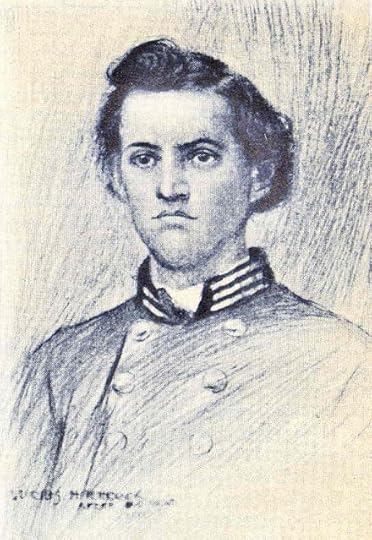 Captain John Watson Morton, a former student of General Bushrod Johnson, was captured at Fort Donelson in 1862 but joined Forrest's command after his exchange and quickly gained Forrest's trust as one of his most daring and accomplished subordinates. At Brice's Crossroads, Morton charged the retreating Federal forces with his guns as he recounts in the following letter.
Captain John Watson Morton, a former student of General Bushrod Johnson, was captured at Fort Donelson in 1862 but joined Forrest's command after his exchange and quickly gained Forrest's trust as one of his most daring and accomplished subordinates. At Brice's Crossroads, Morton charged the retreating Federal forces with his guns as he recounts in the following letter. Mississippi
June 1864
Dear father,
Kind heaven has again favored us witha glorious victory, a brilliant victory does not express it. General Forresthas achieved many brilliant victories but this far exceeds everything else hehas accomplished or anyone else in this war. We met the enemy at 10 o’clock onthe 10th, expecting only to skirmish with them until the train couldpass, wishing to draw them down to the prairies where we could get at thembetter as our force was quite small compared to theirs. We had in the fightfour brigades: Bell’s, Kentucky, Rucker’s, and Johnson’s brigade from Roddywith two batteries, Rice’s and mine, all numbering 4,500 men. Johnson had only800 men. The enemy’s force was variously estimated from 8,000-17,000 butgenerally believed by almost everyone at 10,000 men with 20 pieces ofartillery.
The fight raged furiously for threehours, the enemy evincing much stubbornness. About 1 o’clock, everything,artillery and all, was ordered to charge. Our line moved promptly with adeafening shout and hail of bullets and balls which told terribly upon theenemy which broke their lines and put them in perfect confusion and rout. Theymade eight determined stands but the promptness and rapidity of our movementscompletely baffled their expectations and drove them from the field afterfighting half or one hour. We were so rapid in our charges with artillery thattheir batteries did them no good after the first fight. They attempted to takepositions but were routed before they could fire more than two or three shots.
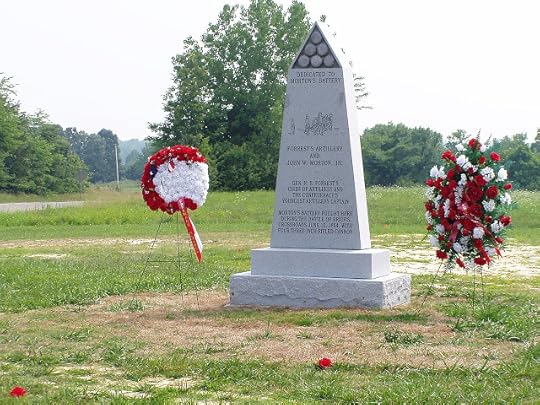 Morton's Battery monument on the Brice's Crossroads battlefield.
Morton's Battery monument on the Brice's Crossroads battlefield. I charged with the batteries ninetimes. Once I had two pieces a little in advance of the others and with them ina charge was 20 or 30 yards in advance of our line when we drove the enemy.Just before we captured their wagons, they made a desperate stand and with theirreserves concentrated, charged our right flank which gave way and fell backupon the two right pieces of my battery. The enemy moved up steadily, pouring adestructive fire into our ranks until they got within 50 yards of our twopieces. We changed projectiles, double charged the guns with canister, pouredtwo volleys into their ranks and this checked them. Three more volleys with theassistance of our lines formed on us and with a yell and a charge we drove themfrom the field.
We followed them 50 miles the nextday, skirmished with them, and drove them all the night succeeding, scatteringthem over the entire country. There will 100 in a squad ever arrive back atMemphis; they are still being picked up and brought in. It is not recorded inthe history of this war or any other where the infantry marched so rapidly andfar as they did- 120 miles in 14 hours.
We captured, 2,500 prisoners, 300 wagons and ambulancesloaded with ordnance, commissary, and medical stores, 16 pieces of artillery,13 caissons, and killed and wounded 1,500 men. A good many Negroes werecaptured but have a few of them prisoners. Our loss was 800 killed and wounded.I had one man killed and nine wounded in the artillery but only one of thewounded would consent to go to the hospital- all told me they would remain withtheir guns as long as they could ride or walk. I never saw such a determinedspirit in my life as everyone exhibited. Forrest’s cavalry can’t be whipped.
The general [Forrest] had paid the artillery some highcompliments and says he never saw artillery handled better in his life and thathe is indebted to for the victory. Without us, he could not have accomplishedanything but would have been ruined. He says that he is particularly proud ofmy battery; they are the best men he has and if he had had three such batterieshe could have whipped them without any other assistance. All the battery boyshave immortalized themselves. None of our Nashville boys were hurt.
Source:
Letter fromCaptain John Watson Morton, Morton’s Tennessee Battery, Atlanta SouthernConfederacy (Georgia), July 5, 1864, pg. 2
June 9, 2025
Got Badly Scooped: A Federal Gunner at Brice’s Crossroads
As his two-gunsection of the 7th Wisconsin Battery rolled towards Brice’sCrossroads, Mississippi on the afternoon of June 10, 1864, Private Isaac Denny grewperplexed at General Sturgis’s troop deployments.
“Sturgis evidently was unaware of the presence in great forcefor he kept his trains moving to the front, even after the battle opened,”Denny noted in a letter to his brother back home in Wisconsin. “The wagons andambulances were jammed right in among us and it looked to me as if he intendedto charge the enemy with his supply train. After we had fought five hours andthe retreat was ordered, upon going a few rods we found that the damned supplytrain was still there. A regular stampede ensued. The roads were so blockaded thatwe were obliged to take to the fields. We started with both of our guns but gotstuck in the mud and abandoned one of them.”
Federal artillery accounts of Brice’s Crossroads are rare ashens’ teeth, so it is with pleasure that I share Private Denny’s account whichresides in Volume 10 of the Quiner Scrapbooks of the Wisconsin HistoricalSociety.
 Private Denny and the 7th Wisconsin Battery escaped the logjam at the Tishomingo Creek bridge during the retreat phase of the Battle of Brice's Crossroads but eventually had to abandon their guns in the swamps on the road to Ripley.
Private Denny and the 7th Wisconsin Battery escaped the logjam at the Tishomingo Creek bridge during the retreat phase of the Battle of Brice's Crossroads but eventually had to abandon their guns in the swamps on the road to Ripley. Memphis,Tennessee
June 14,1864
The right wing of the battery hadanother whack at old Forrest but we got badly scooped this time. We started inthe direction of Corinth on the 1st instant under Generals Sturgisand Grierson. As we understood it, the object of the expedition was to engagethe attention of the Rebels and prevent them from interfering with Sherman’scommunications and Sturgis was under positive orders to avoid, if possible, ageneral engagement. This order he seems to have disregarded.
On the seventh day about sundown, wereached Ripley. As we entered the town our advance was having a lively skirmishbut as no artillery was used we were merely spectators. The Rebs fell back andwe resumed our march the next day and for four successive days we followed abrigade of Rebs until finally we were piloted into the main Rebel camp and gotbadly scooped. The battle commenced on the 10th at 10 a.m. and theretreat was ordered at 5 p.m.
Sturgis evidently was unaware of the presence in great forcefor he kept his trains moving to the front, even after the battle opened. Thewagons and ambulances were jammed right in among us and it looked to me as ifhe intended to charge the enemy with his supply train. After we had fought fivehours and the retreat was ordered, upon going a few rods we found that thedamned supply train was still there. A regular stampede ensued. The roads wereso blockaded that we were obliged to take to the fields. We started with bothof our guns but got stuck in the mud and abandoned one of them.
We kept moving all night and in the morning were at Ripleyagain, 26 miles from the battleground. We remained there half an hour when theRebs charged into and we out of it. They hung upon our rear with a heavy force.When within 50 miles of Memphis, our infantry and cavalry were out ofammunition. We halted half an hour with heavy firing in front; started again,and continued the retreat all night through fields and swamps dark as tar.
“Themen in their desperation broke their guns over stumps and trees, throwing awaytheir empty cartridge boxes, coats, and even shoes, anything that would impedethem in their flight. Not a mouthful of provision in the whole army, thecountry a barren and desolate waste and the cavalry of the enemy harassing themon every side. Worn down and broken in spirit, they trudged on all nightthrough the mud and mire. The horses of the batteries were killed but everypiece of artillery was brought off the field by hand. They could not be saved.One captain took an axe and cut down the wheels, spiking his guns, throwing theammunition in the swamp. Words cannot picture the horrors of the retreat.” ~ A Federaleyewitness
Johnny Davis, Ed Topliff, and myself traveled until our horseplayed out. Then we slept awhile and awoke just in time to save ourselves fromcapture and did not halt again until we reached Memphis making 110 miles in 48hours. During the battle, we were frequently under deadly fire, but no memberof the 7th sustained any injury though men were killed from the gunsadjoining us. Six of our own men are missing: Sergeant John Warren, JamesBurton, Andrew and Joseph Wright, and two new recruits whose names I do notremember.
Sources:
Letter fromPrivate Isaac C. Denny, 7th Wisconsin Battery, Quiner Scrapbooks ofthe Wisconsin Historical Society, Volume 10
Letter fromJ.G., Evansville Daily Journal (Indiana), July 18, 1864, pg. 1
June 3, 2025
For Victuals and Abraham Lincoln: Summering in Maryland in 1864
The 144th Ohio Infantry, a hundred days' regiment, arrived in Maryland in May 1864 and was promptly dispatched in detachments across the state. While Grant and the Army of the Potomac and Lee's Army of Northern Virginia hammered away at each other, Co. F found itself with light duties and time on their hands at the little town of Annapolis Junction.
"Our duties are light, and at their leisure the boys have reconnoitered the surrounding country on private account, and been rewarded by the discovery of the abundance of cherries and mulberries-of which we are welcome to all we choose to pick," recalled Private Henry S. Chapin. "The consequence is that some of our company keep up a continual skirmishing with the cherry trees and up to the present time the advantage has invariably been in our favor that we have all the fruit we can eat-which, by the way, is no small amount. There is also any quantity of blackberries and huckleberries within easy range of our camp, which are already beginning to ripen; peach and apple trees in this locality are also loaded with fruit. There need, therefore, be no fear of suffering for want of the necessities of life."
Within a few short weeks, the sense of quiet in Maryland would turn to panic when General Jubal Early led his army into the state. A portion of the 144th Ohio would fight at Monocacy on July 9, 1864 to contest Early's advance, but the men of Co. F would miss out on the action. Henry S. Chapin's letter first saw publication in the June 30, 1864, edition of the Perrysburg Journal; Chapin was the editor of the newspaper.
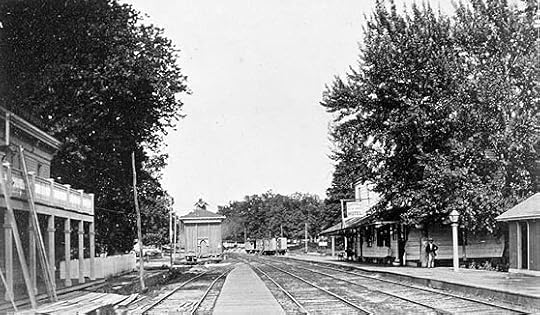 A familiar sight to the men of Co. F: the railroad depot at Annapolis Junction, Maryland. The company spent nearly their entire 100 day service guarding this junction, only leaving as Early's army passed within a dozen miles of town and the troops ordered back to Annapolis to guard Camp Parole.
A familiar sight to the men of Co. F: the railroad depot at Annapolis Junction, Maryland. The company spent nearly their entire 100 day service guarding this junction, only leaving as Early's army passed within a dozen miles of town and the troops ordered back to Annapolis to guard Camp Parole. AnnapolisJunction, Md.
June15, 1864
On Monday last, I wrote you that therewere no serious cases of sickness in Company F. At that time such was mybelief, and the general belief of the company. True, we had a couple of men inthe hospital, but we had not thought either of them to be dangerously ill.About 9 o’clock yesterday morning, however, we were startled by receiving wordthat Leonard Snyder, of this company, was dead. He had been unwell for a numberof days, but remained in camp until Friday last, when he was worse, and had tobe taken most of the way to the hospital on a stretcher.
His disease was pronounced by the physicians tobe typhoid fever, but members of the company who have seen frequent cases ofbrain fever, say that his attack and subsequent symptoms strongly resembled it.He improved however and on Sunday morning I am told he was able to sit up, andconversed with some members of the company who called to see him though hecould talk but little at a time. Since Sunday afternoon, he appeared to bederanged all the time, except perhaps a few minutes Monday morning. Early Tuesdaymorning a member of the company went to see him and found him insensible inwhich condition he remained until about 6 o’clock when he died.
His remains were placed in a coffin bymembers of the company and at 11 o’clock this morning we followed him to asoldier’s grave. The funeral procession was formed as follows:
MILITARY ESCORT: under command ofCorporal Stewart with arms reversed- composed of the following persons: LewisHouseholder, Harvey Phillips, Alanson Bushnell, Eli Scott, Alvin C. Austin,Thomas Shanks, John Priest, Isaac Smith.
PALL BEARERS: Alexander Bruce, LewisSchaller, James Russell, Peter Algoner, Charles Champion, William Stein.
Then followed members of the companyand officers.
Arrived at the grave, the escorthalted in front of it-the company standing in line in rear of the escort. ThePall Bearers then lowered the coffin into the grave-the escort presenting arms.The Hospital Chaplain then read a portion of the Scriptures and offered up aprayer, after which the escort fired three volleys over the grave. The companythen formed in the same order as before and returned to camp, leaving the deadsoldier, so lately our associate.
Leonard Snyder, was a resident ofWebster Township, Wood County. He was not, when we left Perrysburg, a member ofthis company, but belonged to the company from Webster and Freedom townshipswhich was broken up at Camp Chase, when he was assigned to Company F. He hasresided in Webster township for 8 or 10 years past; has been married but wasdivorced from his wife about two or three years since. I am told that he hascousins residing somewhere in Wood County but no relatives in Webster Township.His father resides near Syracuse, New York. His age was 31.
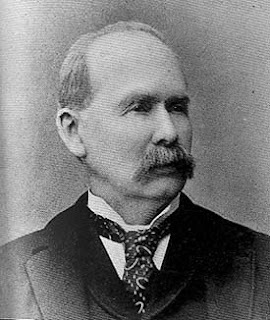 Henry S. Chapin
Henry S. ChapinEditor, Perrysburg Journal
I had no acquaintance with the deceased previousto his connection with this company- since that time, however, I have known himas a kind friend and a soldier always ready and willing to do any duty requiredof him. Possibly- had he made as great an effort as some who were members ofthis company- he might have obtained an exemption and remained at home, andtoday been in his usual health, but he responded to the call of Governor Broughand has fallen in the service of his country. And I appeal to you readers,whether the memory of this dead solider-whatever may have been his past faultsor failings- in his late sickness knew no mother’s or sister’s care and whosegrave was watered by no relative’s tear, is he not a thousand times more worthyof the honor and respect of his countrymen than is the man who sneaked fromservice of his country, and remains at home-a live healthy coward?
The only member of Company F now in Hospital isRobert Emmons, who was severely bruised a day or two since, by falling from acherry tree. No bones were broken, however, and he is recovering.
Here in the immediate vicinity of Company Fremain in stata quo and no change of base is regarded as probable before theexpiration of our term of our service.
The health of the company is good. With theexception of Emmons-who fell from a cherry tree but is now able to get around-there is no member of the company in hospital here. I have however, failed tonotice that Caleb Miller was some time since sent to the hospital at RelayBarracks, he having been unwell ever since we left home.
It is my opinion that we are enjoying much betterthan average fare of soldiers in camp. Our duties are light, and at theirleisure the boys have reconnoitered the surrounding country on private account,and been rewarded by the discovery of the abundance of cherries andmulberries-of which we are welcome to all we choose to pick. The consequence isthat some of our company keep up a continual skirmishing with the cherry treesand up to the present time the advantage has invariably been in our favor thatwe have all the fruit we can eat-which, by the way, is no small amount. Thereis also any quantity of blackberries and huckleberries within easy range of ourcamp, which are already beginning to ripen; peach and apple trees in thislocality are also loaded with fruit. There need, therefore, be no fear ofsuffering for want of the necessities of life.
Thursday evening last President Lincoln and partypassed this place in a special train for Philadelphia-but the train did notstop. However, when he returned on Friday the train was detained for 15 or 20minutes, when the President appeared on the platform of the car, bowed to thecrowd, but didn’t “make a speech!”
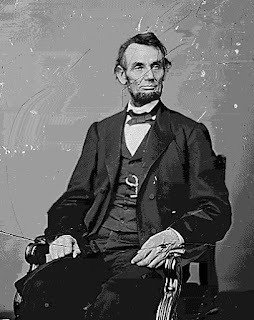 President Abraham Lincoln
President Abraham Lincoln On Sunday last a collision occurred on theWashington branch of the Baltimore & Ohio Railroad about half a mile fromour camp. The two locomotives were considerably injured, the front end of apassenger car broken in and a lieutenant seriously bruised; two freight carsfilled with cavalry horses were completely wrecked and the platform of onebeing raised off its trucks, and sliding on the platform of the other,unceremoniously scattering the horses out of the other side, yet none of themwere injured, with the exception of a few slight scratches.
On Thursday morning last, in company with Lieut.Tyler and Sergts. Averill and Bates I visited Washington, and very soon afterour arrival we commenced on an exploration of the curiosities of the NationalCapital. Time and space forbid that I should attempt even the briefestdescription of what to us was interesting and seemed worthy of mention; yet Icannot forebear a brief general allusion to the most important objects ofinterest.
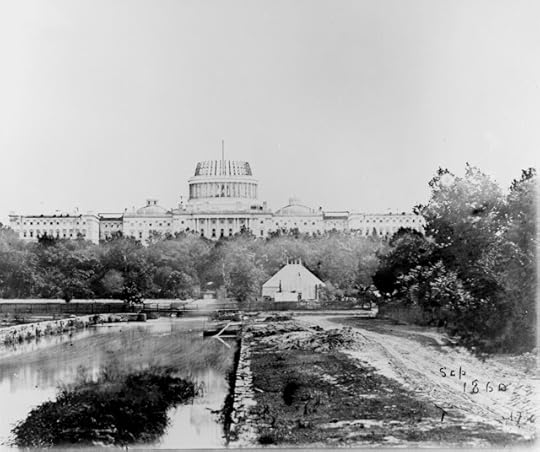 The Capitol building under construction during the Civil War.
The Capitol building under construction during the Civil War. Of course, the first thing which attracts theattention of a stranger is the Capitol building-the extent and grandeur ofwhich surpassed even the idea I had formed of it from many descriptions whichhave been so freely circulated by the newspapers. The Capitol of Ohio is a finebuilding and an honor to the state, yet it would appear like an unattractivepygmy if placed beside the Capitol of the Nation.
Among other public buildings which we visitedwere the Treasury Department, Post Office Department, President’s Mansion,Smithsonian Institute, and Patent Office. The two latter are truly, in the fullest sense of the term, curiosityestablishments. At the Smithsonian may be seen specimens of almost every knownvariety of beasts and birds-stuffed of course-looking much more natural andlife-like than the sickly specimens to be seen in traveling menageries, also,specimens of fishes, rocks, minerals, & c. In fact, almost everything to befound in air, earth, or water. Our visit here was short and one glance at thevarious specimens a hasty one, yet we were convinced that the Smithsonian wasone of the interesting features of Washington. In the same catalogue howevermay be enumerated the Patent Office, where may be seen models of all themachinery, implements, & c. for which patents have been issued; also manyrare and curious articles manufactured in foreign countries, the originalDeclaration of Independence and Commission of Washington as Commander-in Chiefare to be seen- both, however, are very much faded and the signatures are veryindistinct. The printing press at which Benjamin Franklin worked when ajourneyman printer in London is also to be found there.
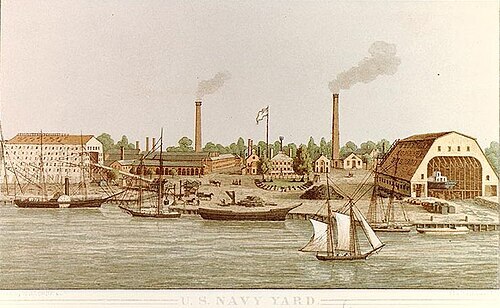 Washington Navy Yard in 1862.
Washington Navy Yard in 1862. Friday morning we visited the Navy Yard, andpassed through a number of shops connected therewith, were we saw in process ofconstruction articles for the navy many times too numerous to publish. Amongmany other things in the relic department were two small brass guns broughtfrom Spain by Cortez and also used by him in the conquest of Mexico. There werealso a large number of implements of war which had been captured in battle.
Our visit to the President’s Mansion wasunattended by important results. We found a fellow with his feet in a chair,apparently enjoying a delightful snooze at one of the windows of the East Room-but it wasn’t “Old Abe”, we concluded it was a sleepy sentinel. Finding doorsopen and meeting with no opposition, we proceeded to usher ourselves throughsome of the apartments, but didn’t see “Father Abraham”- in fact he had fled-he couldn’t stand the descent of the “One Hundred Days’ Men” and had consequentlygone to Philadelphia to attend the Sanitary Fair. In his absence, however, oneof our crowd placed himself in a statesmanlike attitude and received thebalance of the party with “distinguished consideration.” After this wewithdrew, feeling confident that although we had not seen the President we hadseen where he had been. And this reminds me of an interesting incident whichonce happened away out in Illinois, but as I was not there when it happened, Iwill not attempt to related it, but go for my rations.
Yoursfor victuals and A. Lincoln,
H.S.C.
Source:
Letter from Private Henry S. Chapin, Co. F, 144th Ohio Infantry, Perrysburg Journal (Ohio), June 30, 1864, pg. 2
June 2, 2025
Dispatch from a Shebang: The 83rd Indiana on the Road to Atlanta
"I am now seated on the lap of mother earth, my left knee serving the purpose of a writing desk under the artistically constructed roof of what is in the army usually denominated a shebang," began one soldier of the 83rd Indiana in describing the night of June 21, 1864. "I am seated in a shebang where on the whole I am rather comfortable everything considered and quite secure from the rain which at present is falling thick and fast and pattering musically- a regular rub-a-dub-dub on everything around me. And this has been its practice with brief intervals during the present month scarcely a day going by without more or less rain. This under the most favorable circumstances makes soldiering disagreeable and especially so on an active campaign when tents are bygone luxuries and one has to cook, eat, and sleep out of doors."
The misery would reach new heights a few days later when the 83rd Indiana took part in the assault on Kennesaw Mountain, a day "day will not be apt to be forgotten by most of the members of the Second Division."
Both of the following letters, written by members of the 83rd Indiana Infantry, first saw publication in the pages of the Aurora Journal.
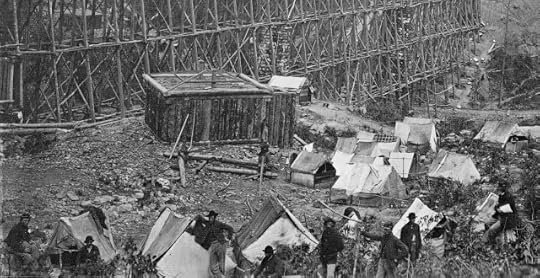 A collection of shelter tents and "shebangs" guard the railroad trestle at Whitesides, Tennessee in the summer of 1864. As the war progressed, soldiers became quite adept at "making do" with whatever they could find in the field that could add to their comfort. Studying the picture carefully, one can see old rugs and ragged coats being used as part of the shelters along with spare bits of lumber, boxes, etc.
A collection of shelter tents and "shebangs" guard the railroad trestle at Whitesides, Tennessee in the summer of 1864. As the war progressed, soldiers became quite adept at "making do" with whatever they could find in the field that could add to their comfort. Studying the picture carefully, one can see old rugs and ragged coats being used as part of the shelters along with spare bits of lumber, boxes, etc. In the fieldnear Kennesaw Mountain, Georgia
June 21,1864
I am now seated on the lap of motherearth, my left knee serving the purpose of a writing desk under the artisticallyconstructed roof of what is in the army usually denominated a shebang. Whatthis beautiful and to the soldier very expressive word is derived from or whereit has any derivation is more than I am able to determine. Certainly, it is aword both known and understood in the army and should any old battle-worncampaigner or young veteran at home see the word in this article, I feel quitecertain that he will at once recognize an old friend and understand us withoutdifficulty.
Well, as I said before, I am seated ina shebang where on the whole I am rather comfortable everything considered andquite secure from the rain which at present is falling thick and fast andpattering musically- a regular rub-a-dub-dub on everything around me. And thishas been its practice with brief intervals during the present month scarcely aday going by without more or less rain. This under the most favorablecircumstances makes soldiering disagreeable and especially so on an activecampaign when tents are bygone luxuries and one has to cook, eat, and sleep outof doors.
Such has been our fortune ormisfortune for the last two months and we have no well-defined idea when itshall be otherwise but we are indulging in hopes that this campaign willterminate in the complete overthrow of the rebellion and the end of ourprivations and labors.
When I wrote last, the 83rdIndiana was halted near Acworth, Georgia and pretty well to the front as usual,but since then the front has moved forward several miles and we, faithful toour former practice, moved with it. At the present writing we are resting behindrifle pits which we threw up last evening about 400 yards from the base ofKennesaw Mountain which the Rebels occupy and have well-fortified. The groundwhich we occupy now was held by the enemy up to Saturday night when, inconsequence of a flank movement by Hooker on our right, the enemy was compelledto straighten his line and fall back to the mountain. He was strongly fortifiedhere, so much so that I doubt if we ever could have routed him by assault.
Our work on Sunday was to advance and take possession of theabandoned works, drive back his skirmishers, bring up and plant our battery,etc. While doing this, the enemy shelled us but with little effect. I thinkthere was but one man killed in the division and he belonged to the 55thIllinois.
Yesterday there was heavy fighting on our right. Hooker ispressing the enemy severely. It is generally supposed that Johnston isretreating to the other side of the Chattahoochee River and that the force inour immediate front is nothing more than a strong rear guard covering hisretreat. This is not unlikely. We have captured vast numbers of the enemy andmany more have voluntarily surrendered. The probabilities are that we willsurround the enemy in our front (I mean the whole force on the mountain) andcapture the whole thing, both men and guns. What make this probable is whileHooker is pressing their left, General Rousseau is swinging round their rightwith a large force and between these two, I think the Johnnies stand a goodchance of being trapped.
We have had no casualties in the 83rd since mylast. The health of the regiment is good. We are drawing full rations, Rebelreports to the contrary notwithstanding. All the boys are in good spirits andfull of hope and confidence.
W.F.S.
A weeklater, the regiment took part in the assault on Kennesaw Mountain as rememberedby Hospital Steward Daniel C. Beach who picks up the story from where our previouscorrespondent left off...
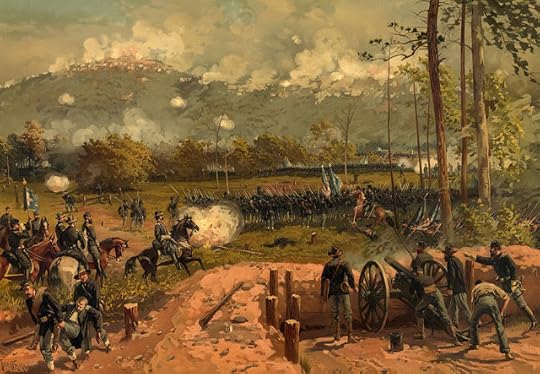 The Battle of Kennesaw Mountain, Georgia, June 27, 1864.
The Battle of Kennesaw Mountain, Georgia, June 27, 1864. Near BigShanty, Georgia
June 29,1864
On the night of June 23rd,the enemy retired to the top of the mountain, evidently with the intention ofinducing us to follow, but we concluded not to venture and remained within theworks. We sent a skirmish line partway up the mountain but finding they couldnot reach the top, they returned to their position near the base.
Sunday the 26th was thequietest day we enjoyed during the campaign but the work was soon to begin.After dark, the 15th Army Corps was removed from the front and againtaking position about two miles further to the right, quietly awaiting the dawnof the 27th of June. That day will not be apt to be forgotten bymost of the members of the Second Division.
At about 8:30 a.m., the order was given to advance and in theface of a withering fire of musketry, they started. They had not proceeded manyyards when the enemy’s batteries opened upon them. At very short range and anenfilading hail of shot and shell poured down upon them. But like the undauntedheroes they are, they pressed on driving the enemy from his first ditches in a hand-to-handencounter, many of them clubbing their muskets and rushing in with a recklessdaring.
About 9 o’clock, the generals, finding that it would beimpossible for the men to hold their position under such a heavy fire, gave theorder to fall back and slowly but steadily the Second Division gave way,retiring about 200 yards. Then they halted and maintained their position theentire day. During the night, the division was relieved by the First Divisionunder General Osterhaus. We retired about a mile and are now resting andrecovering from the effects of the charge.
Having been ordered to the rear in charge of a number of sickfrom the regiment, I was at the divisional hospital when the wounded came inand was busy from 9 o’clock until 11 at night, assisting in dressing theirwounds. Upwards of 50 cases were compelled to wait until the next day to gettheir wounds attended to; among the wounded in the 83rd Indiana is thatgallant officer Colonel Ben Spooner. His loss is deeply felt by the regiment,who know him but to esteem and love him. [Colonel Spooner was wounded in theleft arm which was amputated.]
To learn more about the Battle of Kennesaw Mountain, please check out these posts:
Gentlemen, this is serious business: A 57th Ohio captain recalls Kennesaw
Billy had No Enemies: The Death of Captain William D. Neal
The Golden Moment was Gone: The Doomed Assault on the Dead Angle at Kennesaw
They Paid Dearly for Their Whistle Today: Rebel Views of Kennesaw Mountain
Sources:
Letter fromW.F.S., 83rd Indiana Volunteer Infantry, Aurora Journal(Indiana), July 7, 1864, pg. 2
Letter fromHospital Steward Daniel C. Beach, 83rd Indiana Volunteer Infantry, AuroraJournal (Indiana), July 14, 1864, pg. 4
May 31, 2025
No Hope for the Johnnies: Battery C at Bentonville
ShermanHendrick of Battery C, 1st Ohio Light Artillery had fought as partof the Army of the Cumberland since its inception. But at Bentonville, North Carolinain March 1865, he saw something he had rarely seen on a battlefield: the 14thCorps running away from a fight.
“Soon after our arrival, we heard agreat uproar towards the front and saw pack mules, baggage wagons, and part ofa battery coming back in great disorder,” he recalled. “Our advancing brigadeshad been flanked by an overwhelming force and came back in awful confusion. Thecommand was given, “Right wheel into battery!” At 3:15 p.m., we were in goodshape for callers. We were no sooner in position than the 14th Corpsbrigade came running through our line, one captain crying out, “Lee’s wholearmy is after us! Run for your lives, boys, run!” The 14th Corpsboys were not in the habit of running away from a fight, so we knew that theremust be something ahead worth running for. But we were there first and meant tohold our ground.”
Hendrick’s battery, attached to the 20thArmy Corps, would hold their ground for the rest of the battle, its last majorengagement of the Civil War. Corporal Hendrick’s description of Bentonvillefirst appeared in the June 30, 1892, edition of the National Tribune.
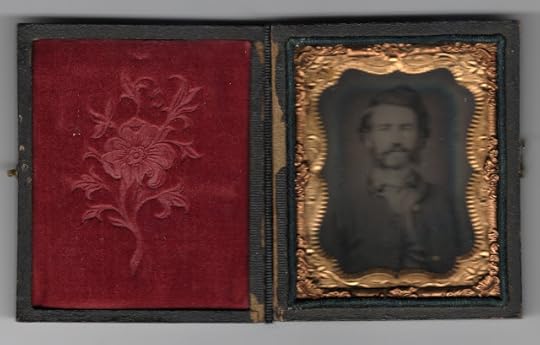 Private John D. Thompson, Battery C, 1st Ohio Volunteer Light Artillery
Private John D. Thompson, Battery C, 1st Ohio Volunteer Light Artillery On Sunday March 19, 1865, we marchedat 7:30 a.m. on the Bentonville road from the direction of Averysboro. At 10a.m., we heard artillery ahead where the 14th Corps was fighting theenemy under General Joseph Johnston. The enemy was slowly driven back untilthey reached entrenchments near Bentonville.
We reached this point at 2:40 p.m. andwent into park in an open field near a house and peach orchard. We had seen thepeach trees in bloom all morning, it being regular spring warm and the roadsmuddy. As we came to a halt, the lines were extended to the left by the 20thCorps to which Battery C was now attached, forming on the left of the 14thCorps. All the time there was hard skirmishing in front nearly a mile ahead ofus. Two brigades, one of the 14th and one of 20th Corps,were advancing upon the Rebel work to try their position.
Soon after our arrival, we heard agreat uproar towards the front and saw pack mules, baggage wagons, and part ofa battery coming back in great disorder. Our advancing brigades had beenflanked by an overwhelming force and came back in awful confusion. The commandwas given, “Right wheel into battery!” At 3:15 p.m., we were in good shape forcallers. We were no sooner in position than the 14th Corps brigadecame running through our line, one captain crying out, “Lee’s whole army isafter us! Run for your lives, boys, run!” The 14th Corps boys werenot in the habit of running away from a fight, so we knew that there must besomething ahead worth running for. But we were there first and meant to holdour ground. General [James S.] Robinson formed his brigade to support ourbattery, the only one on the field, and then began the work of rallying thefleeing troops. The flag bearer of the 82nd Ohio halted to the leftof our battery and rallied his comrades by waving the colors and calling, “Whereis the 82nd Ohio?”
All this had taken place in 15 minutesand we had redoubts started three rails high in front of our pieces when theRebels came out of the woods in the front and on the left of us about 500 yardsaway. As they emerged from the woods, our skirmishers heard their officers say,“Boys, go for that battery,” and they started. But about this time was our putin and we sent them a volley of case shot cut just right to burst among them.We kept this up as fast as we could load and fire and they soon fell back tothe cover of the woods.
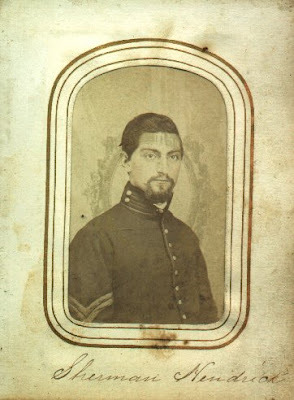 Corporal Sherman Hendrick
Corporal Sherman HendrickBattery C, 1st O.V.L.A.
As soon as they did this, troops wereadvanced to the edge of the woods on our right and left, leaving our front forus to take care of while we strengthened our works. In the meantime, Battery I,1st New York Light Artillery, had arrived and taken position, readyto assist in repelling the second charge. Before the third charge, anotherbattery was in position belonging to the 14th Corps. The Rebelscharged seven times before dark but as we were reinforced all the time, theydid not get out of the woods after the first charge.
During the second charge, Corporal.D.A. Reed of Battery C was severely wounded and died three days afterwards andwas buried on the way to Goldsboro. Battery M, 1st New York LightArtillery arrived about 5 p.m. making four batteries in position, ready forbusiness at the same old stand. There was now no hope for the Johnnies; ourlines were too strong and they retired to their works.
Battery C fired 271 rounds, mostly caseshot. The first charge was repulsed wholly by case shot, showing that to be apowerful weapon when properly used. The 20th Corps arrived not aminute too soon as the 14th Corps was being roughly handled byJohnston’s whole army. Battery C had the honor of saving the day by repulsingthat first charge. Not that we did any better than would any of the otherbatteries, but we were there and they were not. The infantry, as always, didtheir duty. But I was watching the enemy and the work of the artillery that dayand had a large open field to do it in so I can say but little for the work ofthe infantry.
As the enemy was charging us, it waspreeminently an artillery battle and proved the efficacy of case shot fortreating that kind of disease. It certainly did good execution as was proved bythe line of dead left in the open field from the first charge and from the factthat the enemy could not be coaxed or driven out of the woods to meet thoseshrieking, bursting shells a second time. They would form back in the woods andcome up to the opening all right, but there they would break and rush back outof reach, then form and advance to break and fall back again.
This is Bentonville as I saw it.
Source:
“Bentonville,N.C.: The Part Taken by Battery C, 1st Ohio L.A. in one of Sherman’slast fights,” Corporal Sherman Hendrick, Battery C, 1st OhioVolunteer Light Artillery, National Tribune, June 30, 1892, pg. 3
Daniel A. Masters's Blog
- Daniel A. Masters's profile
- 1 follower



